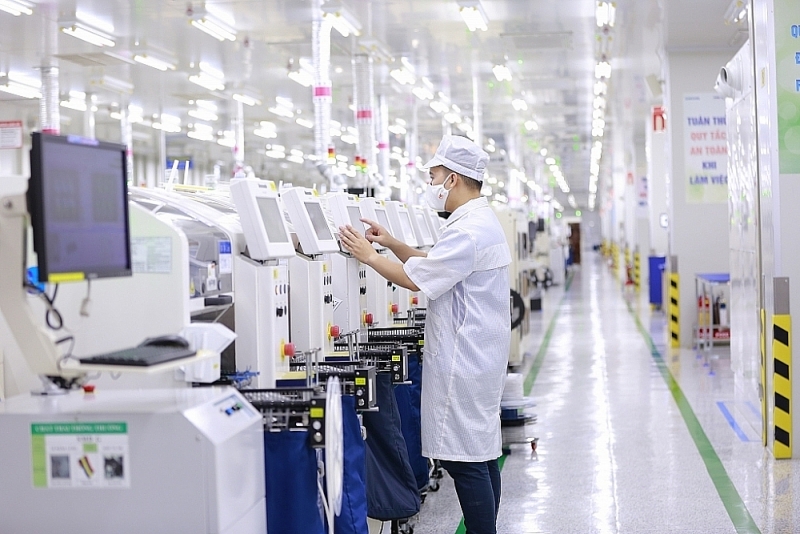 |
| Samsung is one of the largest Korean enterprises investors in Vietnam. Photo: Tran Ngoc |
Attract great investment
Korea has been one of Vietnam’s largest investment partners for many years, making an important contribution to Vietnam’s economic development.
Speaking of Korean businesses investing in Vietnam, Samsung’s investment project with a total investment value exceeding the threshold of US$20 billion must be mentioned when recently (June 2022), the additional investment has pushed the figure up to US$841 million for Samsung Complex HCMC – SEHC (Samsung’s largest global TV and home appliance manufacturing factory). Another Samsung project in Thai Nguyen – Samsung Electro-mechanics Vietnam (SVMC) also raised capital by US$267 million in June. With these new investments, Samsung continues to maintain its position as the largest foreign investor in Vietnam.
According to the Foreign Investment Agency, Ministry of Planning and Investment, in the first six months of 2022, Korean investors have registered to invest over $2.66 billion in Vietnam, accounting for nearly 19% of the total capital investment, up 29.6% over the same period last year. Trade turnover between Vietnam and Korea reached US$500 million in 1992, by 2021, it has increased to US$78 billion. The two sides are aiming for bilateral import and export growth to reach US$100 billion in 2023 and US$150 billion in 2030. |
Many other large corporations of Korea have also chosen Vietnam as an investment destination with large projects.
Hanwha Group has recently entered into a joint venture with Vietnam’s T&T Group to invest in the Hai Lang Gas Power Project (Quang Tri) with investment capital of US$2.3 billion in phase I. LG Group has located twice in 2021 for LG Display, bringing the total investment capital of LG Display in Vietnam to US$4.65 billion. Amkor has also invested in a semiconductor manufacturing project in Bac Ninh, with the scale of phase I being US$500 million.
Kwon Sung-Taek, Vice President of the Korea-Vietnam Economic and Cultural Association (KOVECA), said that in the ASEAN region, the bilateral trade turnover between Vietnam and the Republic of Korea is equal to the total value of the remaining nine countries.
Regarding production investment, Korean enterprises contribute about 25% of Vietnam’s total export turnover. Korean enterprises have strengths in technology, techniques, experience and capital, while Vietnam has abundant human resources. Previously, Korean enterprises invested in Vietnam with many labor-intensive industries, but the investment trend will focus on many manufacturing and high-tech industries.
Korea aims to increase bilateral trade turnover to US$100 billion in 2023 and US$150 billion in 2030 towards a balanced and sustainable direction, in which increasing the volume of Vietnam’s exports to Korea; encouraging Korean enterprises to increase investment in spearhead industrial fields in parallel with technology transfer to Vietnam; maintaining close cooperation in the field of science and technology especially the implementation of the second phase of the Vietnam – Korea Institute of Science and Technology (VKIST) project, Mr. Kwon Sung-Taek said.
Create a favorable environment
Although highly appreciating the investment potential in Vietnam, sharing at the Conference on Promotion of Korean FDI in Vietnam last weekend, a number of Korean enterprises have faced a lot of obstacles due to the constant change in the legal document system of Vietnam.
Therefore, Korean investors long to have more consistency and transparency in the system of policy regulations, especially investment attraction policies.
Mr. Pham Huu Thang, Vice President, General Secretary of the Association for Liaison with overseas Vietnamese, former Deputy Director of the Foreign Investment Department, Ministry of Planning and Investment, acknowledged that Vietnam is ready to welcome more investment cooperation.
In turn, the partners also have the need and desire to seek investment opportunities. Besides the advantages, there are still certain challenges, so the two sides need to exchange regularly to share and update information and each other’s needs to move towards more specific and effective cooperation.
Given concerns about investment procedures of Korean enterprises, leaders of many localities that have a large number of investment projects of Korean enterprises such as Bac Ninh, Long An, Dong Nai and Khanh Hoa confirmed that such localities are ready to welcome and help Korean investors with more investment opportunities.
As one of the most attractive destinations for FDI enterprises, including Korean ones, Vice Chairman of Bac Ninh Provincial People’s Committee Ngo Tan Phuong said that the province currently has 590 projects with a total capital of about US$14 billion. In which, Samsung is a major investor in the province along with a chain of satellite businesses, contributing to a large export turnover of about US$45 billion, creating jobs and collecting local budgets. That is the success of the province in attracting FDI, especially Korean enterprises.
Bac Ninh has focused on investing in infrastructure for industrial parks (currently Bac Ninh has 36 industrial parks ready to welcome new investors), expanding and investing in new traffic routes, and ensuring electricity supply for industrial zones. In particular, Bac Ninh province has implemented a customs clearance port, ICD Tan Cang – Que Vo ICD, and established an interdisciplinary team ready to answer all questions of businesses, and regularly organize dialogues between provincial leaders and FDI businesses.
Nguyen Thi Hoang, Vice Chairman of Dong Nai People’s Committee, said that Dong Nai province currently attracts more than 1,500 FDI projects with a total investment of about US$33 billion, of which Korean investors have 426 projects. with an investment capital of US$7 billion.
Korean key investment sectors in Dong Nai are mainly supporting industries, producing electronic components. To attract more FDI, Dong Nai is planning eight new industrial parks with a total area of 8,500 ha. Unlike before, Dong Nai will attract investment selectively, prioritizing high-tech and innovative science projects.
